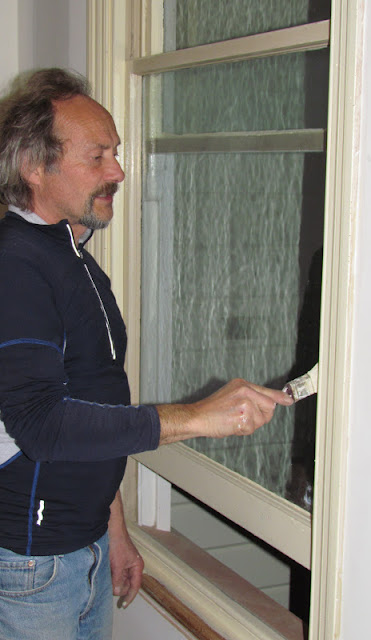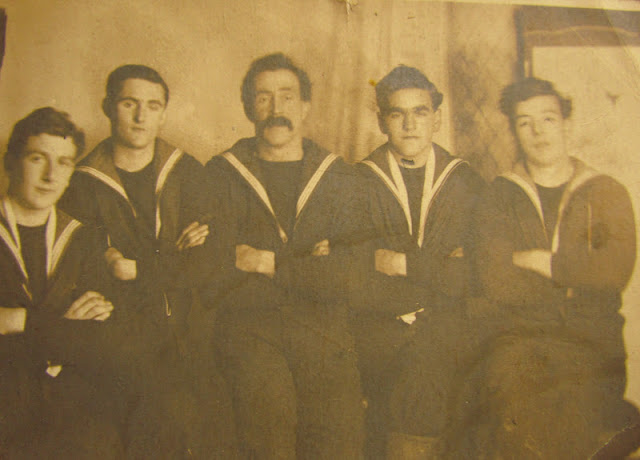It's time for me to make some progress with the Skudder House, to continue sorting through family effects. I decided, on the weekend, to assess my father's Antarctic book collection. Most of it I expected to find in his tin trunk. What I didn't expect to find were relics of an older generation, although I am not surprised to find that my father valued his own father's keepsakes.
Although my father, Derrick, talked very little about his father, I have gleaned enough over the years from him and other family members, to know that my grandfather was a telegraphist with the Royal Corps of Signals. The words on the badge above, sparked realisation that the little hoard (in the cardbox box heading this post) related specifically to Hector Baden Hobby. The photograph shows where he wore this badge - one of two on the collar of his uniform - and a Christmas card that he painted showing his telegraph station at Carrickfergus.
Finding the box of mementoes was not enough on its own to inspire me to dip into my own collection of documents and photographs, but something nudged me to open a mysterious letter that I received from my Uncle Bill while I was in England. I hadn't opened it at the time, knowing that I wanted to give it my full attention, and only now (with quite a few commitments cleared away) did it feel that the time was right to open the envelope. Inside: new knowedge, old knowledge, and the awareness that I could fill in a few gaps.
So now I am making this post especially for a cousin I didn't even know existed: Richard, this is for you and your family, and also for my cousin David - who I do know - and his family.
This photo shows David Hobby, centre, Head Gardener at Brympton d'Evercy, with other members of staff. The man in the bowler hat standing behind David is the spitting image of my younger brother, so may be a member of the family, possibly his son William - our great-grandfather and successor to his position. Certainly there is photographic evidence of another Hobby in household service at Brympton, which ties in with mention of a butler, Thomas. These photos by the way, were part of a collection owned by Clive Ponsonby-Fane, who alerted me to various family relics during a visit in 1991.

Although it is clear that David and William were both gardeners at Brympton d'Evercy near Yeoville in Somerset, they may also have worked at nearby Montecute House. If William was fully employed at Montecute, as Richard's research suggests, then the care of those huge hedges - before they had developed their fabulous billowing form - was a family responsibility. No wonder I have such a pedantic eye for a level cut! Having seen the yew hedges there - for real, and as a dramatic backdrop in Ang Lee's 1995 film of Sense and Sensibility - I can imagine gardeners from miles around being called in to cut them!
Two great great granddaughters and one great great great granddaughter visited David's grave in the churchyard of St Andrews Church at Brympton in 1995. The inscription on it reads:
In loving memory of
David Hobby
Who died February 15th 1905
Aged 66 Years
"Thou will keep him in perfect peace, whose mind is stayed on thee."
Also of Eliza
Widow of the above
Died January 3rd 1912
Aged 75 Years
It's interesting to note the Sydenham monument inside the church with its inscription beginning:
My founder Sydenham matcht to Hobyes heyr.
The Tudor dynasty of Hobys was suffering from lack of issue by the 17th century, and Thomas Hoby (a portrait of his brother Edward, hangs in Montecute House) bequeathed his Yorkshire Manor of Hackness to a Somerset family that was destined to loose its fortune... along with Brympton d'Evercy. Yet someone bearing the Hoby name, though not the fortune, proved fecund enough to maintain a Hobby presence amongst the serving class at Brympton right into the 20th century. In 1891 the Lodge was built for David and Eliza. This substantial family home can be seen at the entrance to Brympton House.
The photo above is of William Hobby (David's son) and his wife Margaret. Recognisable family charachteristics are William's smiling eyes and the set of his mouth which I remember in my father, and Margaret's thick black wavy hair which passed down to my father and continues through my younger brother.
Some of my information differs to that gathered by Richard, but I feel that through my close correspondence with my grandmother, Doreen, and other family members, birthdates, names and so on are as reliable as public records. The date I have for Hector's birth is 4th June 1900. He was the youngest of four children:
Harold, Ernest, and Dorothy, with whom he is pictured above, were his siblings.
William Hobby probably succeeded to the position of Head Gardener at Brympton after his father's death. The
family were still part of the Brympton household after the outbreak of War in 1914 judging by an inscription in a copy of Walter Raymond's Crafts and Character. It is a poignant thought that this gift was not only a Christmas present to a servant's child but a farewell gift as the old order disintegrated. The book still bears the bookplate of the Spencer Ponsonby Fane Library and I like to think that it was selected especially for a boy who loved the people and customs of the English countryside. I understand that Mrs de Grey was the Housekeeper at the time, but she may have had a different role in the household.

I know very little about Hector's siblings but there are references to Earnest, who is pictured below with his son Roderick John Hobby. Earnest emigrated to Canada and does seem to have kept in contact with his mother judging by a proud grandmother's entry in a Clever Children Contest. Mrs W Hobby entered 5 year old Roderick's photo in the contest in January 1923, when she was living at The Laurels, Saint Nicholas, nr Cardiff.

According to Richard's research Earnest did revisit Britain and may
have given these Canada badges to his parents or brother on one of these occasions.
Meanwhile Hector (2nd from right) appears to have joined the navy, but judging by the date and subject matter of his water-coloured Christmas card he had joined the Royal Corps of Signals before he was twenty. He married Emma Doreen Lenighan in Belfast on 8th October 1925 and was serving in India by the time Derrick was born in Quetta in 1927.
Doreen had lived in India as a child, enjoying the privileges accorded an officer's family, and felt keenly her diminished status as an NCO's wife. Still, the many photos that she and Hector took of their family during this time, mostly stationed at Rawalpindi, show a happy indulgent family atmosphere. Two daughters, Joan and Dorothy were also born in India.
Derrick was six when the family returned to England and lived for a time with Hector's parents in Leeds. Fir Tree Lane was a place that my father did mention with a sense of fondness. From there Hector and his growing family moved to North Yorkshire where he was stationed at Catterick Camp. Four more children were born: James, known as Ted, Pamela, Colin and Lionel.
Doreen and Colin still shared the family home at No 11 Brough Avenue, Colburn, when my mother took us to visit in 1967.
Alcoholism marred Hector's latter years, and I suspect this is why my father spoke so little of him. Derrick was only fourteen when his father died of lung cancer on January 2nd 1942. Hector was buried in Hipswell Churchyard, having been refused medical benefits and a soldier's burial, as he was discharged from the army once he succumbed to illness. This injustice remained a grievance to my grandmother until she died in 1994.
The badge above, appears to be one of my father's as he was a member of the 1st Colburn-Hipswell Scout Troop, though his father may also been involved with it. There was certainly a strong Scouting tradition in the family. How could there not be with a name like Hector Baden!
Amongst all these symbols of masculine achievement, was this ring: a woman's ring. Imagining that it had most likely been Hector's mother's ring I am moved to think I have something that belonged to my great grandmother, Margaret Hobby. I know so little about her, not even where she is buried although it is likely that she is in the cemetry at Alwoodley, Leeds, beside my great grandfather William Hobby.
Derrick Hobby - a non-smoker - died of lung cancer on
6 August 1989 aged 62 and is buried in the
Rangiora Lawn Cemetry.
I have also written about this side of my family in:
The Lost Uncle












.jpg)










.jpg)

































